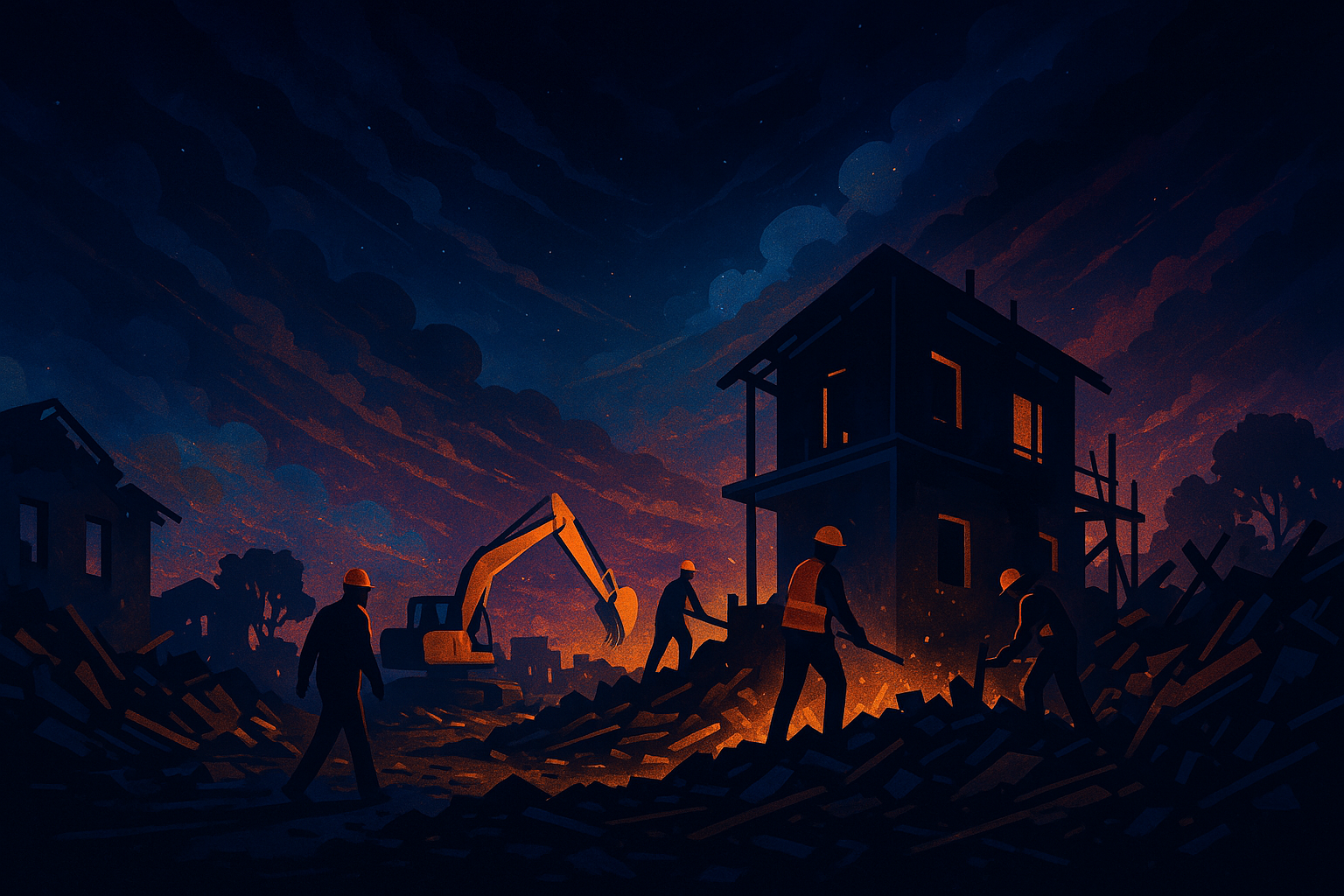Introduction
In an era characterized by frequent and increasingly severe natural and man-made disasters, from hurricanes and floods to wildfires and pandemics, post-disaster recovery planning has become an essential component of community preparedness and sustainable development. Beyond immediate emergency response, recovery planning serves as a blueprint for restoring livelihoods, rebuilding infrastructure, and enhancing the long-term well-being of affected populations. When approached through the lens of sustainable development and community resilience, post-disaster recovery transforms from a reactive measure to a proactive and strategic process that fosters long-term growth, social equity, and environmental stewardship.
This essay explores the significance of post-disaster recovery planning in relation to sustainable development and resilience building. It discusses key principles, challenges, and opportunities, emphasizing the need for inclusive, adaptive, and forward-thinking strategies that align with global sustainability goals and empower communities to withstand and recover from future shocks.
Understanding Post-Disaster Recovery Planning
Post-disaster recovery planning refers to the process of preparing for and managing the restoration of a community after a disaster. It includes short-term recovery actions like restoring basic services and long-term strategies such as rebuilding housing, infrastructure, healthcare systems, and livelihoods. Effective recovery planning seeks not merely to return to the pre-disaster status quo, but to build back better—addressing vulnerabilities and laying the groundwork for a more resilient and equitable future.
Recovery planning typically includes:
- Damage assessment and needs analysis
- Housing and infrastructure reconstruction
- Restoration of social services
- Economic revitalization
- Environmental management
- Community engagement and participation
The overarching goal is not only physical reconstruction but also psychological healing, social cohesion, and economic revival.
Sustainable Development and Its Nexus with Disaster Recovery
Sustainable development is defined by the United Nations as “development that meets the needs of the present without compromising the ability of future generations to meet their own needs.” It encompasses three core dimensions: economic growth, social inclusion, and environmental protection. Post-disaster recovery provides a critical opportunity to integrate these pillars, particularly in areas vulnerable to recurring hazards.
1. Economic Dimension
Disasters often disrupt local economies, destroy livelihoods, and deepen poverty. Sustainable recovery planning aims to:
- Support small businesses and local industries.
- Promote green jobs and sustainable tourism.
- Rebuild infrastructure with resilient and energy-efficient technologies.
Investing in economic diversification and inclusive job creation during recovery strengthens local economies and reduces future risk.
2. Social Dimension
Recovery planning has immense social implications. Disasters often exacerbate existing inequalities, with marginalized groups suffering disproportionally. Sustainable recovery ensures:
- Equitable access to resources and services.
- Protection of vulnerable populations (e.g., women, children, the elderly, people with disabilities).
- Community participation in decision-making processes.
By fostering social cohesion and inclusion, recovery contributes to lasting peace and stability.
3. Environmental Dimension
Disasters frequently result in environmental degradation, from soil erosion and deforestation to water contamination and loss of biodiversity. Sustainable recovery entails:
- Rehabilitation of ecosystems.
- Promotion of nature-based solutions (e.g., mangrove restoration for coastal defense).
- Adoption of eco-friendly building practices.
An environmentally conscious recovery enhances ecological resilience and supports long-term sustainability.
Community Resilience: The Cornerstone of Recovery
Community resilience is the capacity of individuals, households, and communities to anticipate, absorb, adapt to, and recover from adverse events. Post-disaster recovery planning plays a pivotal role in strengthening this resilience by:
- Building knowledge and awareness of risks.
- Enhancing local governance and institutional capacity.
- Supporting community-led initiatives and local innovation.
Resilient communities are not only better equipped to respond to disasters but also to thrive in the face of climate change, economic uncertainty, and other systemic challenges.
The Importance of “Building Back Better”
A core principle of effective recovery planning is “Build Back Better” (BBB), introduced by the UN following the 2004 Indian Ocean tsunami. BBB advocates for:
- Safer and more resilient infrastructure.
- Improved land-use planning.
- Stronger legal and institutional frameworks.
- Integration of disaster risk reduction into recovery efforts.
BBB ensures that recovery is not simply a return to vulnerability but a leap toward resilience and sustainability.
The Role of Policy, Governance, and International Frameworks
Governance and policy frameworks significantly influence the success of post-disaster recovery and its alignment with sustainable development.
International Frameworks
Several global agendas provide guidance:
- The Sendai Framework for Disaster Risk Reduction (2015–2030) emphasizes risk-informed recovery and resilient infrastructure.
- The Sustainable Development Goals (SDGs), particularly Goals 1 (No Poverty), 11 (Sustainable Cities), and 13 (Climate Action), underscore the link between disaster resilience and development.
- The Paris Agreement highlights the role of adaptation and climate resilience in sustainable development.
National and Local Policies
Governments must develop:
- Comprehensive recovery policies with clear roles and responsibilities.
- Risk-sensitive land-use and urban planning.
- Budgetary allocations for post-disaster reconstruction and preparedness.
Decentralization and empowerment of local authorities enhance responsiveness and contextual relevance of recovery plans.
Challenges in Post-Disaster Recovery Planning
Despite its critical importance, recovery planning faces multiple challenges:
1. Lack of Preparedness
Many communities do not have pre-disaster recovery plans in place, leading to ad-hoc and inefficient responses.
2. Resource Constraints
Limited financial and human resources hamper the implementation of sustainable and inclusive recovery strategies.
3. Coordination Issues
Recovery involves multiple stakeholders—governments, NGOs, private sector, and communities. Lack of coordination can lead to duplication of efforts or gaps in service delivery.
4. Data Gaps
Accurate data on damages, needs, and vulnerabilities is essential for informed planning. Often, this data is unavailable or unreliable post-disaster.
5. Social Inequities
Recovery efforts may inadvertently favor the more privileged, leaving marginalized populations further behind.
Best Practices and Strategies for Effective Recovery Planning
1. Community-Centric Approach
Involving communities in all stages of recovery planning—from assessment to implementation—ensures relevance, ownership, and sustainability.
2. Pre-Disaster Planning
Developing recovery frameworks and conducting simulations before disasters strike enable faster and more coordinated action when needed.
3. Risk-Informed Investment
Channeling funds into resilient infrastructure and risk reduction minimizes future losses and supports long-term development.
4. Integrated Planning
Linking recovery with development planning, environmental management, and poverty reduction ensures a holistic approach.
5. Monitoring and Learning
Establishing mechanisms to track progress and learn from past experiences fosters continuous improvement.
Case Studies: Lessons from the Field
1. Japan – Tōhoku Earthquake and Tsunami (2011)
Japan’s recovery process showcased strong governance, rapid response, and community involvement. Investments in resilient infrastructure, mental health services, and disaster education contributed to long-term resilience.
2. New Orleans – Hurricane Katrina (2005)
The recovery highlighted issues of social inequity, but also led to urban redevelopment with better flood management systems, affordable housing initiatives, and improved emergency planning.
3. Nepal – Earthquake (2015)
Despite challenges, Nepal’s reconstruction efforts emphasized local labor, heritage conservation, and inclusive planning, supporting both recovery and economic revitalization.
The Role of Education and Capacity Building
Education is central to both sustainable development and disaster resilience. Recovery planning should integrate:
- Disaster risk education in schools and communities.
- Training programs for local officials, planners, and responders.
- Public awareness campaigns on preparedness and sustainable rebuilding.
Empowered individuals are the first line of defense against disaster impacts and key drivers of sustainable recovery.
Technology and Innovation in Recovery Planning
Emerging technologies can enhance recovery efforts:
- Geographic Information Systems (GIS) for damage mapping and planning.
- Drones and remote sensing for assessment and monitoring.
- Mobile apps and platforms for community feedback and coordination.
- Green building technologies for sustainable reconstruction.
Innovation accelerates recovery while embedding sustainability and efficiency into processes.
Conclusion
Post-disaster recovery planning is not merely a technical or logistical endeavor—it is a vital process that shapes the future of communities and nations. When approached through the lens of sustainable development and resilience, recovery becomes an opportunity for transformation. It allows societies not only to recover from adversity but to emerge stronger, more inclusive, and better prepared for future challenges.
By prioritizing community participation, integrating environmental considerations, and aligning with development goals, recovery planning can serve as a catalyst for sustainable growth. In a world increasingly impacted by climate change and disaster risk, building resilient, adaptive, and sustainable communities is not optional—it is imperative.




